Cook Islands
| |
|---|---|
 Flag
Flag
 Coat of arms
Coat of arms
| |
| Anthem: Te Atua Mou Ē "God is Truth" | |
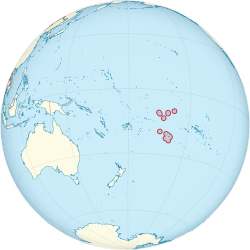 | |
| Capitaland largest city | Avarua 21°12′S 159°46′W / 21.200°S 159.767°W / -21.200; -159.767 |
| Official languages |
|
| Spoken languages |
|
| Ethnic groups (2016 census) |
|
| Demonym(s) | Cook Islander |
| Government | Unitary constitutional monarchy |
| • Monarch | Charles III |
| • King's Representative | Sir Tom Marsters |
| • Prime Minister | Mark Brown |
| • President of the House of Ariki | Tou Travel Ariki |
| Legislature | Parliament |
| Free association with New Zealand | |
| • Self-governance | 4 August 1965 |
| • UN recognition of independence in foreign relations | 1992 |
| Area | |
| • Total | 236.7 km (91.4 sq mi) (unranked) |
| Population | |
| • 2021 census | 15,040 (223rd) |
| • Density | 63.3/km (163.9/sq mi) (138th) |
| GDP (nominal) | 2020 estimate |
| • Total | US$384 million (not ranked) |
| • Per capita | US$21,994 (not ranked) |
| Currency | New Zealand dollar (NZD)Cook Islands dollar (formerly) |
| Time zone | UTC–10 (CKT) |
| Drives on | Left |
| Calling code | +682 |
| ISO 3166 code | CK |
| Internet TLD | .ck |
| |
The Cook Islands (Rarotongan: Kūki ‘Airani; Penrhyn: Kūki Airani) is an island country in Polynesia, part of Oceania in the South Pacific Ocean. It consists of 15 islands whose total land area is approximately 236.7 square kilometres (91 sq mi). The Cook Islands' Exclusive Economic Zone (EEZ) covers 1,960,027 square kilometres (756,771 sq mi) of ocean. Avarua is its capital.
The Cook Islands is self-governing while in free association with New Zealand. Since the start of the 21st century, the Cook Islands has directed its own independent foreign and defence policy, and also has its own customs regulations. Like most members of the Pacific Islands Forum, it has no armed forces, but the Cook Islands Police Service owns a Guardian Class Patrol Boat, CIPPB Te Kukupa II, provided by Australia, in order to police its waters. In recent decades, the Cook Islands have adopted an increasingly assertive and distinct foreign policy, and a Cook Islander, Henry Puna, served as Secretary General of the Pacific Islands Forum from 2021 to 2024. Most Cook Islanders are also citizens of New Zealand, but they also have the status of Cook Islands nationals, which is not given to other New Zealand citizens. The Cook Islands have been an active member of the Pacific Community since 1980.
The Cook Islands' main population centres are on the island of Rarotonga (10,863 in 2021). The Rarotonga International Airport, the main international gateway to the country, is located on this island. The census of 2021 put the total population at 14,987. There is also a larger population of Cook Islanders in New Zealand and Australia: in the 2018 New Zealand census, 80,532 people said they were Cook Islanders, or of Cook Islands descent. The last Australian census recorded 28,000 Cook Islanders living in Australia, many with Australian citizenship. With over 168,000 visitors to the islands in 2018, tourism is the country's main industry and leading element of its economy, ahead of offshore banking, pearls, and marine and fruit exports.
Etymology
The Cook Islands comprise 15 islands split between two island groups, which have been called individual names in indigenous languages including Cook Islands Māori and Pukapukan throughout the time they have been inhabited. The first name given by Europeans was Gente Hermosa (beautiful people) by Spanish explorers to Rakahanga in 1606.
The islands as a whole are named after British Captain James Cook, who visited during the 1770s and named Manuae "Hervey Island" after Augustus Hervey, 3rd Earl of Bristol. The southern island group became known as the "Hervey Islands" after this. In the 1820s, Russian Admiral Adam Johann von Krusenstern referred to the southern islands as the "Cook Islands" in his Atlas de l'Ocean Pacifique. The entire territory (including the northern island group) was not known as the "Cook Islands" until after its annexation by New Zealand in the early 20th century. In 1901, the New Zealand parliament passed the Cook and other Islands Government Act, demonstrating that the name "Cook Islands" only referred to some of the islands. However, this situation had changed by the passage of the Cook Islands Act 1915, which defined the Cooks' area and included all presently included islands.
The islands' official name in Cook Islands Māori is Kūki 'Āirani, a transliteration of the English name.
History
Main articles: History of the Cook Islands and British Western Pacific TerritoriesThe Cook Islands were first settled around AD 1000 by Polynesian people who are thought to have migrated from Tahiti, an island 1,154 kilometres (717 mi; 623 nmi) to the northeast of the main island of Rarotonga.
The first European contact with the islands took place in 1595 when the Spanish navigator Álvaro de Mendaña de Neira sighted the island of Pukapuka, which he named San Bernardo (Saint Bernard). Pedro Fernandes de Queirós, a Portuguese captain at the service of the Spanish Crown, made the first European landing in the islands when he set foot on Rakahanga in 1606, calling the island Gente Hermosa (Beautiful People).
British explorer and naval officer Captain James Cook arrived in 1773 and again in 1777, giving the island of Manuae the name Hervey Island. The Hervey Islands later came to be applied to the entire southern group. The name "Cook Islands", in honour of Cook, first appeared on a Russian naval chart published by Adam Johann von Krusenstern in the 1820s.
In 1813 John Williams, a missionary on the colonial brig Endeavour (not the same ship as Cook's) made the first recorded European sighting of Rarotonga. The first recorded landing on Rarotonga by Europeans was in 1814 by the Cumberland; trouble broke out between the sailors and the Islanders and many were killed on both sides. The islands saw no more Europeans until English missionaries arrived in 1821. Christianity quickly took hold in the culture and many islanders are Christians today.
The islands were a popular stop in the 19th century for whaling ships from the United States, Britain and Australia. They visited, from at least 1826, to obtain water, food, and firewood. Their favourite islands were Rarotonga, Aitutaki, Mangaia and Penrhyn.

The Cook Islands became aligned to the United Kingdom in 1890, largely because of the fear of British residents that France might occupy the islands as it already had Tahiti. On 6 September 1900, the islanders' leaders presented a petition asking that the islands (including Niue "if possible") should be annexed as British territory. On 8 and 9 October 1900, seven instruments of cession of Rarotonga and other islands were signed by their chiefs and people. A British Proclamation was issued, stating that the cessions were accepted and the islands declared parts of Her Britannic Majesty's dominions. However, it did not include Aitutaki. Even though the inhabitants regarded themselves as British subjects, the Crown's title was unclear until the island was formally annexed by that Proclamation. In 1901 the islands were included within the boundaries of the Colony of New Zealand by Order in Council under the Colonial Boundaries Act, 1895 of the United Kingdom. The boundary change became effective on 11 June 1901, and the Cook Islands have had a formal relationship with New Zealand since that time.
The Cook Islands responded to the call for service when World War I began, immediately sending five contingents, close to 500 men, to the war. The island's young men volunteered at the outbreak of the war to reinforce the Māori Contingents and the Australian and New Zealand Mounted Rifles. A Patriotic Fund was set up very quickly, raising funds to support the war effort. The Cook Islanders were trained at Narrow Neck Camp in Devonport, and the first recruits departed on 13 October 1915 on the SS Te Anau. The ship arrived in Egypt just as the New Zealand units were about to be transferred to the Western Front. In September 1916, the Pioneer Battalion, a combination of Cook Islanders, Māori and Pakeha soldiers, saw heavy action in the Allied attack on Flers, the first battle of the Somme. Three Cook Islanders from this first contingent died from enemy action and at least ten died of disease as they struggled to adapt to the conditions in Europe. The 2nd and 3rd Cook Island Contingents were part of the Sinai-Palestine campaign, first in a logistical role for the Australian and New Zealand Mounted Rifles at their Moascar base and later in ammunition supply for the Royal Artillery. After the war, the men returned to the outbreak of the influenza epidemic in New Zealand, and this, along with European diseases meant that a large number did not survive and died in New Zealand or on their return home over the coming years.
When the British Nationality and New Zealand Citizenship Act 1948 came into effect on 1 January 1949, Cook Islanders who were British subjects automatically gained New Zealand citizenship. The islands remained a New Zealand dependent territory until the New Zealand Government decided to grant them self-governing status. On 4 August 1965, a constitution was promulgated. The first Monday in August is celebrated each year as Constitution Day. Albert Henry of the Cook Islands Party was elected as the first Premier and was knighted by Queen Elizabeth II. Henry led the nation until 1978, when he was accused of vote-rigging and resigned. He was stripped of his knighthood in 1979. He was succeeded by Tom Davis of the Democratic Party who held that position until March 1983.
On 13 July 2017, the Cook Islands established Marae Moana, making it become the world's largest protected area by size.
In March 2019, it was reported that the Cook Islands had plans to change its name and remove the reference to Captain James Cook in favour of "a title that reflects its 'Polynesian nature'". It was later reported in May 2019 that the proposed name change had been poorly received by the Cook Islands diaspora. As a compromise, it was decided that the English name of the islands would not be altered, but that a new Cook Islands Māori name would be adopted to replace the current name, a transliteration from English. Discussions over the name continued in 2020.
On 25 September 2023, the United States recognised Cook Islands sovereignty and established diplomatic relations.
Geography
Main article: Geography of the Cook Islands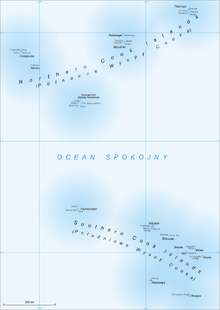
The Cook Islands are in the South Pacific Ocean, north-east of New Zealand, between American Samoa and French Polynesia. There are 15 major islands spread over 2,200,000 km (850,000 sq mi) of ocean, divided into two distinct groups: the Southern Cook Islands and the Northern Cook Islands of coral atolls.
The islands were formed by volcanic activity; the northern group is older and consists of six atolls, which are sunken volcanoes topped by coral growth. The climate is moderate to tropical. The Cook Islands consist of 15 islands and two reefs. From March to December, the Cook Islands are in the path of tropical cyclones, the most notable of which were the cyclones Martin and Percy. Two terrestrial ecoregions lie within the islands' territory: the Central Polynesian tropical moist forests and the Cook Islands tropical moist forests.
| Island group |
Island | Area (km) |
Population census 2021 |
Density per km |
|---|---|---|---|---|
| Northern | Penrhyn | 9.8 | 230 | 23.5 |
| Northern | Rakahanga | 4.1 | 81 | 19.8 |
| Northern | Manihiki | 5.4 | 207 | 38.3 |
| Northern | Pukapuka | 1.3 | 456 | 350.8 |
| Northern | Tema Reef (submerged) | 0 | 0 | – |
| Northern | Nassau | 1.3 | 92 | 70.8 |
| Northern | Suwarrow | 0.4 | 0 | – |
| Southern | Palmerston | 2.1 | 25 | 11.9 |
| Southern | Aitutaki | 18.3 | 1,776 | 97.0 |
| Southern | Manuae | 6.2 | 0 | - |
| Southern | Takutea | 1 | 0 | - |
| Southern | Mitiaro | 22.3 | 155 | 7.0 |
| Southern | Atiu | 26.9 | 382 | 14.2 |
| Southern | Mauke | 18.4 | 249 | 13.5 |
| Southern | Winslow Reef (submerged) | 0 | 0 | – |
| Southern | Rarotonga | 67.1 | 10,863 | 161.9 |
| Southern | Mangaia | 51.8 | 471 | 9.1 |
| Total | Total | 236.7 | 14,987 | 63.3 |
Note: The table is ordered from north to south. Population figures from the 2021 census.
Gallery
-
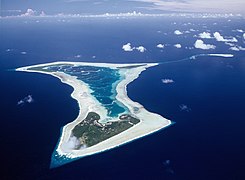 Aerial photograph of Pukapuka
Aerial photograph of Pukapuka
-
 Tapuaetai (One Foot Island) on the southern part of Aitutaki
Tapuaetai (One Foot Island) on the southern part of Aitutaki
-
 Beach on Rarotonga
Beach on Rarotonga
Politics and foreign relations
Main articles: Politics of the Cook Islands and Foreign relations of the Cook Islands Further information: Political status of the Cook Islands and Niue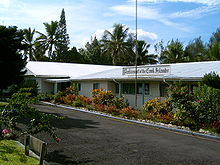

The Cook Islands are a representative democracy with a parliamentary system in an associated state relationship with New Zealand. Executive power is exercised by the government, with the Prime Minister as head of government. Legislative power is vested in both the government and the Parliament of the Cook Islands. While the country is de jure unicameral, there are two legislative bodies with the House of Ariki acting as a de facto upper house.
There is a multi-party system. The Judiciary is independent of the executive and the legislature. The head of state is the King of New Zealand, who is represented in the Cook Islands by the King's Representative.
The islands are self-governing in "free association" with New Zealand. Under the Cook Islands constitution, New Zealand cannot pass laws for the Cook Islands. Rarotonga has its own foreign service and diplomatic network. Cook Islands nationals have the right to become citizens of New Zealand and can receive New Zealand government services when in New Zealand, but the reverse is not true; New Zealand citizens are not Cook Islands nationals. Despite this, as of 2018, the Cook Islands had diplomatic relations in its own name with 52 other countries. The Cook Islands is not a United Nations member state, but, along with Niue, has had their "full treaty-making capacity" recognised by the United Nations Secretariat, and is a full member of the World Health Organization (WHO), UNESCO, the International Civil Aviation Organization, the International Maritime Organization and the UN Food and Agriculture Organization, all UN specialized agencies, and is an associate member of the United Nations Economic and Social Commission for Asia and the Pacific (UNESCAP) and a Member of the Assembly of States of the International Criminal Court.
On 11 June 1980, the United States signed a treaty with the Cook Islands specifying the maritime border between the Cook Islands and American Samoa and also relinquishing any American claims to Penrhyn, Pukapuka, Manihiki, and Rakahanga. In 1990 the Cook Islands and France signed a treaty that delimited the boundary between the Cook Islands and French Polynesia. In late August 2012, United States Secretary of State Hillary Clinton visited the islands. In 2017, the Cook Islands signed the UN Treaty on the Prohibition of Nuclear Weapons. On 25 September 2023, the Cook Islands and the United States of America established diplomatic relations under the leadership of Prime Minister Mark Brown at a ceremony in Washington, DC.
In 2024, the Cook Islands' efforts to join the Commonwealth of Nations as a full member were "ongoing" but, despite this, the government was unable to secure an invitation to attend the 2024 Commonwealth Heads of Government Meeting in Samoa.
Defence and police
The Cook Islands Police Service polices its own waters, and shares responsibility for defence with New Zealand, in consultation with the Cook Islands Government and at its request. The total offshore EEZ is about 2 million square kilometres. Vessels of the Royal New Zealand Navy can be employed for this task including its Protector-class offshore patrol vessels. These naval forces may also be supported by Royal New Zealand Air Force aircraft, including P-8 Poseidons.
However, these forces are limited in size and in 2023 were described by the Government as "not in a fit state" to respond to regional challenges. New Zealand's subsequently announced "Defence Policy and Strategy Statement" noted that shaping the security environment, "focusing in particular on supporting security in and for the Pacific" would receive enhanced attention.
The Cook Islands Police Service is the police force of the Cook Islands. The Maritime Wing of the Police Service exercises sovereignty over the nation's EEZ. Vessels have included a Pacific-class patrol boat, CIPPB Te Kukupa commissioned in May 1989 which received a re-fit in 2015 but was withdrawn from service and replaced by a larger and more capable Guardian-class patrol boat, CIPPB Te Kukupa II, which entered service in 2022. Cook Islands has its own customs regulations.
Human rights
Further information: Human rights in the Cook Islands and LGBT rights in the Cook IslandsFormerly, male homosexuality was de jure illegal in the Cook Islands and was punishable by a maximum term of seven years imprisonment; however, the law was never enforced. In 2023, legislation was passed which legalised homosexuality.
Administrative subdivisions
There are island councils on all of the inhabited outer islands (Outer Islands Local Government Act 1987 with amendments up to 2004, and Palmerston Island Local Government Act 1993) except Nassau, which is governed by Pukapuka (Suwarrow, with only one caretaker living on the island, also governed by Pukapuka, is not counted with the inhabited islands in this context). Each council is headed by a mayor.
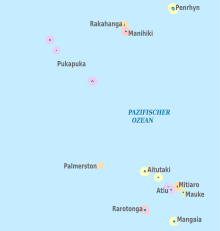

|

|
Aitutaki (including uninhabited Manuae) |

|

|
Atiu (including uninhabited Takutea) |

|

|
Mangaia |

|

|
Manihiki |

|

|
Mauke |

|

|
Mitiaro |

|

|
Palmerston |

|

|
Penrhyn |

|
Pukapuka (including Nassau and Suwarrow) | |

|

|
Rakahanga |

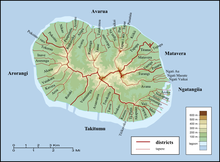
The three Vaka councils of Rarotonga established in 1997 (Rarotonga Local Government Act 1997), also headed by mayors, were abolished in February 2008, despite much controversy.
| Puaikura | Arorangi |
| Takitumu | Matavera, Ngatangiia, Takitumu |
| Te-Au-O-Tonga | (equivalent to Avarua, the capital of the Cook Islands) |
On the lowest level, there are village committees. Nassau, which is governed by Pukapuka, has an island committee (Nassau Island Committee), which advises the Pukapuka Island Council on matters concerning its own island.
Demographics
Main article: Demographics of the Cook Islands| This article needs to be updated. Please help update this to reflect recent events or newly available information. (June 2020) |
| Population pyramid 2011 | ||||||||||||||||||||||||||||||||||||||||||||||||||||||||||||||||||||||||||||||||||||||||||||||||
|---|---|---|---|---|---|---|---|---|---|---|---|---|---|---|---|---|---|---|---|---|---|---|---|---|---|---|---|---|---|---|---|---|---|---|---|---|---|---|---|---|---|---|---|---|---|---|---|---|---|---|---|---|---|---|---|---|---|---|---|---|---|---|---|---|---|---|---|---|---|---|---|---|---|---|---|---|---|---|---|---|---|---|---|---|---|---|---|---|---|---|---|---|---|---|---|---|
| ||||||||||||||||||||||||||||||||||||||||||||||||||||||||||||||||||||||||||||||||||||||||||||||||
Births and deaths
| Year | Population | Live births | Deaths | Natural increase | Crude birth rate | Crude death rate | Rate of natural increase |
|---|---|---|---|---|---|---|---|
| 2009 | 22,600 | 284 | 72 | 212 | 12.6 | 3.2 | 9.4 |
| 2010 | 23,700 | 286 | 92 | 194 | 12.1 | 3.9 | 8.2 |
| 2011 | 14,974 | 262 | 72 | 190 | 13.6 | 3.7 | 9.8 |
| 2012 | 19,500 | 259 | 104 | 155 | 13.3 | 5.3 | 7.9 |
| 2013 | 18,600 | 256 | 115 | 141 | 13.8 | 6.2 | 7.6 |
| 2014 | 18,600 | 204 | 113 | 91 | 11.0 | 6.1 | 4.9 |
| 2015 | 18,400 | 205 | 102 | 103 | 11.0 | 5.5 | 5.5 |
| 2016 | 17,434 | 242 | 87 | 155 | 12.5 | 4.5 | 8 |
| 2017 | 19,500 | 222 | 93 | 129 | 11.4 | 4.8 | 6.6 |
| 2018 | 18,600 | 232 | 121 | 111 | 12.5 | 6.5 | 6 |
| 2019 | 20,200 | 225 | 105 | 120 | 11.1 | 5.2 | 5.9 |
| 2020 |
Religion
Main article: Religion in the Cook IslandsIn the Cook Islands, the Church is separate from the state, and most of the population is Christian. The religious distribution is as follows:

The various Protestant groups account for 62.8% of the believers, the most followed denomination being the Cook Islands Christian Church with 49.1%. Other Protestant Christian groups include Seventh-day Adventist 7.9%, Assemblies of God 3.7% and Apostolic Church 2.1%. The main non-Protestant group are Catholics with 17% of the population. The Church of Jesus Christ of Latter-day Saints makes up 4.4%.
Economy
Main article: Economy of the Cook IslandsThe economy is strongly affected by geography. It is isolated from foreign markets, and has some inadequate infrastructure; it lacks major natural resources except for significant seabed critical minerals, has limited manufacturing and suffers moderately from natural disasters. Tourism provides the economic base that makes up approximately 67.5% of GDP. Additionally, the economy is supported by foreign aid, largely from New Zealand. China has also contributed foreign aid, which has resulted in, among other projects, the Police Headquarters building. The Cook Islands is expanding its agriculture, mining and fishing sectors, with varying success.
Since approximately 1989, the Cook Islands have become a location specialising in so-called asset protection trusts, by which investors shelter assets from the reach of creditors and legal authorities. According to The New York Times, the Cooks have "laws devised to protect foreigners' assets from legal claims in their home countries", which were apparently crafted specifically to thwart the long arm of American justice; creditors must travel to the Cook Islands and argue their cases under Cooks law, often at prohibitive expense. Unlike other foreign jurisdictions such as the British Virgin Islands, the Cayman Islands and Switzerland, the Cooks "generally disregard foreign court orders" and do not require that bank accounts, real estate, or other assets protected from scrutiny (it is illegal to disclose names or any information about Cooks trusts) be physically located within the archipelago. Taxes on trusts and trust employees account for some 8% of the Cook Islands economy, behind tourism but ahead of fishing.
In recent years, the Cook Islands has gained a reputation as a debtor paradise, through the enactment of legislation that permits debtors to shield their property from the claims of creditors.
Since 2008 the Executive Director of Cook Islands Bank has been Vaine Nooana-Arioka.
Infrastructure
See also: Transport in the Cook IslandsThere are eleven airports in the Cook Islands, including one with a paved runway, Rarotonga International Airport, served by five passenger airlines.
Culture
Main article: Culture of the Cook IslandsNewspapers
Newspapers in the Cook Islands are usually published in English with some articles in Cook Islands Māori. The Cook Islands News has been published since 1945, although it was owned by the government until 1989. Former newspapers include Te Akatauira, which was published from 1978 to 1980.

Language
The languages of the Cook Islands include English, Cook Islands Māori (or "Rarotongan"), and Pukapukan. Dialects of Cook Islands Māori include Penrhyn; Rakahanga-Manihiki; the Ngaputoru dialect of Atiu, Mitiaro, and Mauke; the Aitutaki dialect; and the Mangaian dialect. Cook Islands Māori and its dialectic variants are closely related to both Tahitian and to New Zealand Māori. Pukapukan is considered closely related to the Samoan language. English and Cook Islands Māori are official languages of the Cook Islands; per the Te Reo Maori Act. The legal definition of Cook Islands Māori includes Pukapukan.
Music
Main article: Music of the Cook IslandsMusic in the Cook Islands is varied, with Christian songs being quite popular, but traditional dancing and songs in Cook Islands Maori or Pukapukan remain popular.
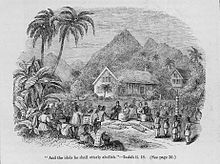
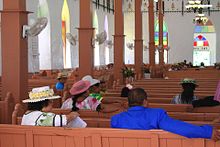
Public holidays
Main article: Public holidays in the Cook IslandsArt
Main article: Art of the Cook IslandsCarving
Woodcarving is a common art form in the Cook Islands. The proximity of islands in the southern group helped produce a homogeneous style of carving but that had special developments in each island. Rarotonga is known for its fisherman's gods and staff-gods, Atiu for its wooden seats, Mitiaro, Mauke and Atiu for mace and slab gods and Mangaia for its ceremonial adzes. Most of the original wood carvings were either spirited away by early European collectors or were burned in large numbers by missionaries. Today, carving is no longer the major art form with the same spiritual and cultural emphasis given to it by the Maori in New Zealand. However, there are continual efforts to interest young people in their heritage and some good work is being turned out under the guidance of older carvers. Atiu, in particular, has a strong tradition of crafts both in carving and local fibre arts such as tapa. Mangaia is the source of many fine adzes carved in a distinctive, idiosyncratic style with the so-called double-k design. Mangaia also produces food pounders carved from the heavy calcite found in its extensive limestone caves.
Weaving
The outer islands produce traditional weaving of mats, basketware and hats. Particularly fine examples of rito hats are worn by women to church. They are made from the uncurled immature fibre of the coconut palm and are of very high quality. The Polynesian equivalent of Panama hats, they are highly valued and are keenly sought by Polynesian visitors from Tahiti. Often, they are decorated with hatbands made of minuscule pupu shells that are painted and stitched on by hand. Although pupu are found on other islands the collection and use of them in decorative work has become a speciality of Mangaia. The weaving of rito is a speciality of the northern islands, Manihiki, Rakahanga and Penrhyn.
Tivaevae
A major art form in the Cook Islands is tivaevae. This is, in essence, the art of handmade Island scenery patchwork quilts. Introduced by the wives of missionaries in the 19th century, the craft grew into a communal activity, which is probably one of the main reasons for its popularity.
Contemporary art
The Cook Islands has produced internationally recognised contemporary artists, especially in the main island of Rarotonga. Artists include painter (and photographer) Mahiriki Tangaroa, sculptors Eruera (Ted) Nia (originally a film maker) and master carver Mike Tavioni, painter (and Polynesian tattoo enthusiast) Upoko'ina Ian George, Aitutakian-born painter Tim Manavaroa Buchanan, Loretta Reynolds, Judith Kunzlé, Joan Gragg, Kay George (who is also known for her fabric designs), Apii Rongo, Varu Samuel, and multi-media, installation and community-project artist Ani O'Neill, all of whom currently live on the main island of Rarotonga. Atiuan-based Andrea Eimke is an artist who works in the medium of tapa and other textiles, and also co-authored the book 'Tivaivai – The Social Fabric of the Cook Islands' with British academic Susanne Kuechler. Many of these artists have studied at university art schools in New Zealand and continue to enjoy close links with the New Zealand art scene.
New Zealand-based Cook Islander artists include Michel Tuffery, print-maker David Teata, Richard Shortland Cooper, Nina Oberg Humphries, Sylvia Marsters and Jim Vivieaere.
Bergman Gallery (formerly BCA Gallery) is the main commercial dealer gallery in the Cook Islands, situated in the main island of Rarotonga, and represents Cook Islands artists such as Sylvia Marsters, Mahiriki Tangaroa, Nina Oberg Humphries, Joan Gragg and Tungane Broadbent The Art Studio Gallery in Arorangi, was run by Ian George and Kay George is now Beluga Cafe. There is also Gallery Tavioni and Vananga run by Mike Tavioni and The Cook Islands National Museum also exhibits art.
Wildlife

- The national flower of the Cook Islands is the tiare māori or tiale māoli (Penrhyn, Nassau, Pukapuka).
- The Cook Islands have a large non-native population of ship rat and kiore toka (Polynesian rat). The rats have dramatically reduced the bird population on the islands.
- In April 2007, 27 Kuhl's lorikeets were re-introduced to Atiu from Rimatara. Fossil and oral traditions indicate that the species was formerly on at least five islands of the southern group. Excessive exploitation for its red feathers is the most likely reason for the species's extinction in the Cook Islands.
- The Islands' surrounding waters are the home of the peppermint angelfish. While they are common, due to the difficulty of harvesting them they are one of the most expensive marine aquarium fish with a price of US$30,000.
Sport
Main article: Sport in the Cook IslandsThe Cook Islands have competed at the Summer Olympic Games since 1988, but have never won a medal. Rugby league is the national and most popular sport in the Cook Islands.
See also
- Index of Cook Islands–related articles
- List of Cook Islanders
- List of islands
- Outline of the Cook Islands
References
- "Cook Islands". The World Factbook (2025 ed.). Central Intelligence Agency. 26 October 2021. (Archived 2021 edition.)
- "Census of Population & Dwellings 2016 Results". Ministry of Finance & Economic Management. 2016. Table 2: Social Characteristics – Sheet 2.3. Archived from the original on 12 July 2021. Retrieved 26 December 2019.
- UN the World Today (PDF) and Repertory of Practice of United Nations Organs Supplement No. 8; p. 10 Archived 19 October 2013 at the Wayback Machine
- ^ "2021 Census of Population and Dwellings". Cook Islands Statistics Office. Section 3 of download. Retrieved 23 September 2023.
- UNCTAD. "UNCTADstat – General Profile: Cook Islands". UNCTADstat. Retrieved 9 August 2021.
- Cook Islands Maori dictionary by Jasper Buse & Raututi Taringa, Cook Islands Ministry of Education (1995) p. 200
- "Search result: "Cook Islands"". Cook Islands Languages. Retrieved 11 March 2023.
- Fisheries, Ecosystems and Biodiversity. Sea Around Us
- "Cook Islands". France in New Zealand. 13 March 2014. Archived from the original on 27 June 2015. Retrieved 30 October 2015.
Since 2001, the Cook Islands has complete sovereignty in managing their Foreign affairs according to the common declaration of 6 April 2001.
- "Statement of the Forum Chair, Cook Islands PM Mark Brown on the Transition in Leadership at the Pacific Islands Forum Secretariat". forumsec.org. Retrieved 5 June 2024.
- "2018 Census ethnic group summaries – Cook Islands Maori". Statistics New Zealand. Retrieved 22 January 2022.
- "Ancestry 1st response (ANC1P)". Australian Bureau of Statistics. 15 October 2021. Retrieved 24 July 2022.
- "Cook Islands welcome more visitors". Radio New Zealand. February 2019. Archived from the original on 8 September 2019.
- ^ Hooker, Brian (1998). "European discovery of the Cook Islands". Terrae Incognitae. 30 (1): 54–62. doi:10.1179/tin.1998.30.1.54.
- ^ "Cook Islands Government website". Cook-islands.gov.ck. Archived from the original on 26 March 2009. Retrieved 18 November 2011.
- Alphons M.J. Kloosterman (1976). Discoverers Of The Cook Islands And The Names They Gave.
- ^ "Cook Islands to choose new indigenous name and remove any association with British explorer". Daily Telegraph. Archived from the original on 11 January 2022. Retrieved 6 March 2019 – via www.telegraph.co.uk.
- ^ "Cook Islands government backs name change body". Radio New Zealand. 5 March 2019. Retrieved 6 March 2019.
- Chikamori, Masashi (1996). "Development of coral reefs and human settlement: Archaeological research in the Northern Cook Islands and Rarotonga". Bulletin of the Indo-Pacific Prehistory Association. 15: 45–52. doi:10.7152/bippa.v15i0.11533 (inactive 1 November 2024). Retrieved 21 August 2020.
{{cite journal}}: CS1 maint: DOI inactive as of November 2024 (link) - Kenneth P. Emory (1963). "East Polynesian Relationships: Settlement Pattern and Time Involved as Indicated by Vocabulary Agreements". Journal of the Polynesian Society. 72 (2): 78–100. Archived from the original on 6 October 2022. Retrieved 26 August 2020.
- Thomas, Nicholas (2003). Cook : the extraordinary voyages of Captain James Cook, Walker & Company, ISBN 0802714129, pp. 310–311.
- ^ "History of the Cook Islands". Ck/history. Retrieved 18 November 2011.
- ^ "Cook Islands profile – Timeline". BBC News. 9 January 2018. Retrieved 19 February 2021.
- Robert Langdon (ed.) Where the whalers went: an index to the Pacific ports and islands visited by American whalers (and some other ships) in the 19th century, (1984) Canberra, Pacific Manuscripts Bureau, pp. 16, 24.
- Ward, Charles James (20 September 1933). "How Cook Islands Became British". IV(3) Pacific Islands Monthly. Retrieved 27 September 2021.
- ^ "Commonwealth and Colonial Law" by Kenneth Roberts-Wray, London, Stevens, 1966. p. 891
- N.Z. Parliamentary p., A3 (1901)
- "Commonwealth and Colonial Law" by Kenneth Roberts-Wray, London, Stevens, 1966. p. 761
- N.Z. Parliamentary Pp., A1 (1900)
- S.R.O. & S.I. Rev. XVI, 862–863
- 58 & 59 V. c. 34.
- "Manava Toa: the Cook Islands in WWI". Auckland Museum. Archived from the original on 13 May 2019. Retrieved 8 June 2021.
- 3. Aliens and citizens – Citizenship – Te Ara Encyclopedia of New Zealand. Teara.govt.nz (4 March 2009). Retrieved 26 December 2012.
- "Cook Islands". The World Factbook (2025 ed.). Central Intelligence Agency. Retrieved 4 August 2019. (Archived 2019 edition.)
- Craig, Robert D. (2011). Historical Dictionary of Polynesia. Rowman & Littlefield. p. 57. ISBN 978-0-8108-6772-7.
- "Cook Islands Marae Moana legislation passed". RNZ. 13 July 2017. Retrieved 27 February 2022.
- "Cook Islands: Backlash over name change leads to compromise traditional name". Pacific Beat with Catherine Graue. ABC News. 23 May 2019. Retrieved 26 November 2019.
- "Renewed calls for the Cook Islands to take on indigenous name". RNZ. 2 July 2020.
- "Statement on the Recognition of the Cook Islands and the Establishment of Diplomatic Relations". The American Presidency Project. 25 September 2023. Retrieved 25 September 2023.
- "Cook Islands Travel Guide" (with description), World Travel Guide, Nexus Media Communications, 2006. Webpage: WTGuide-Cook-Islands Archived 26 October 2006 at the Wayback Machine.
- "Cook Islands climate: average weather, temperature, precipitation, best time". www.climatestotravel.com. Retrieved 11 August 2020.
- Dinerstein, Eric; Olson, David; Joshi, Anup; Vynne, Carly; Burgess, Neil D.; Wikramanayake, Eric; et al. (2017). "An Ecoregion-Based Approach to Protecting Half the Terrestrial Realm". BioScience. 67 (6): 534–545. doi:10.1093/biosci/bix014. ISSN 0006-3568. PMC 5451287. PMID 28608869.
- "Cook Islands Ministry of Finance and Economic Management, 2021 Census". Archived from the original on 28 August 2017. Retrieved 11 November 2017.
- "Cook Islands System of Government Information". www.paclii.org. Retrieved 1 February 2019.
- "Repertory of Practice" (PDF), Legal.un.org, p. 10, archived from the original (PDF) on 19 October 2013
- "The World today" (PDF), Legal.un.org
- "Treaty Between the United States of America and the Cook Islands on Friendship and Delimitation of the Maritime Boundary Between the United States of America and the Cook Islands (and Exchange of Notes)". Pacific Islands Treaty Series. University of the South Pacific School of Law. Retrieved 18 May 2009.
- "Agreement on Maritime Delimitation Between the Government of the Cook Islands and the Government of the French Republic". Pacific Islands Treaty Series. University of the South Pacific School of Law. Retrieved 4 March 2010.
- "Chapter XXVI: Disarmament – No. 9 Treaty on the Prohibition of Nuclear Weapons". United Nations Treaty Collection. 7 July 2017.
- "On the Establishment of Diplomatic Relations between the United States and the Cook Islands". U.S. Department of State. Retrieved 27 September 2023.
- Mika, Talaia (24 August 2024). "Cook Islands 'not invited' to CHOGM". Cook Islands News. Retrieved 25 August 2024.
- "About Cook Islands". New Zealand – Foreign Affairs and Trade. Retrieved 21 August 2023.
- "Illegal Fishing Targeted" (PDF). Navy Today. December 2021. Retrieved 21 August 2023.
- "More than 20 fishing vessels inspected during New Zealand-led South Pacific fisheries patrol". New Zealand – Ministry for Primary Industries. 11 August 2023. Retrieved 21 August 2023.
- "New Zealand Military 'Not in a Fit State,' Government Says". The Defence Post. 4 August 2023. Retrieved 21 August 2023.
- "Defence Policy and Strategy Statement 2023" (PDF). New Zealand Government. August 2023. Retrieved 21 August 2023.
- "Patrol boat 'born again'". Cook Islands News. 15 May 2015. Retrieved 9 December 2019.
- "Prime Minister Brown to Attend Handover Ceremony for CIPPB Te Kukupa II" (Press release). Ministry of Foreign Affairs and Immigration – Government of the Cook Islands. 9 June 2022. Retrieved 21 August 2023.
- Cook Islands Customs Legislation and Tariffs
- "State Sponsored Homophobia 2016: A world survey of sexual orientation laws: criminalisation, protection and recognition" (PDF). International Lesbian, Gay, Bisexual, Trans and Intersex Association. 17 May 2016. Archived (PDF) from the original on 15 June 2016. Retrieved 19 May 2016.
- "Cook Islands parliament decriminalises homosexuality". RNZ. 15 April 2023. Retrieved 11 June 2023.
- Larmour, Peter and Barcham, Manuhuia. Cook Islands 2004, Transparency International Country Study Report.
- "Rarotonga Local Government (Repeal) Bill To Be Tabled, Cook Islands Government". Cook-islands.gov.ck. Archived from the original on 17 October 2013. Retrieved 17 October 2013.
- Minister asked to answer queries over abolition of Vaka Councils. The Cook Islands Herald, No. 393 (9 February 2008)
- "Demographic Yearbook, Population by age, sex and urban/rural residence: latest available year, 2005–2014" (PDF). UN Data. United Nations. Archived (PDF) from the original on 23 December 2015. Retrieved 4 December 2015.
- "United Nations Statistics Division – Demographic and Social Statistics". Unstats.un.org. Retrieved 24 December 2022.
- ^ "Cook Islands". The World Factbook (2025 ed.). Central Intelligence Agency. Retrieved 10 August 2020. (Archived 2020 edition.)
- Polynesia French Business Law Handbook: Strategic Information and Laws ISBN 1-4387-7081-2 p. 130
- ^ Wayne, Leslie (14 December 2013). "Cook Islands, a Paradise of Untouchable Assets". The New York Times. Archived from the original on 1 January 2022. Retrieved 27 December 2013.
- Rosen, Howard; Donlevy-Rosen, Patricia. "Review of Offshore Jurisdictions: Cook Islands". The Asset Protection News. Archived from the original on 3 February 2014. Retrieved 18 April 2014.
- "Our Managers". 2 October 2021. Archived from the original on 2 October 2021. Retrieved 2 October 2021.
- "Cook Islands". The World Factbook (2025 ed.). Central Intelligence Agency. 18 January 2022. (Archived 2022 edition.)
- ^ Dawrs, Stu. "Research Guides: Pacific Islands Newspapers : Cook Islands". guides.library.manoa.hawaii.edu. Retrieved 16 September 2020.
- "Late Cooks PM a Free Press Leader: PFF - Solomon Times Online". SolomonTimes.com. Retrieved 16 September 2020.
- "Cook Islands". Ethnologue. Retrieved 6 May 2019.
- "Lords of the Dance : Culture of the Cook Islands". Ck. 12 November 2013. Retrieved 31 December 2016.
- "Lords of the Dance : Culture of the Cook Islands". Ck. 12 November 2013. Retrieved 31 December 2016.
- "Tivaevae – Quilts of the Cook Islands". Ck. 15 July 2004. Retrieved 31 December 2016.
- "The Cook Islands Arts Community". Cookislandsarts.com. Archived from the original on 23 April 2016. Retrieved 8 April 2016.
- "Gallery director cautious as global market 'fairly immune so far' ..." Cook Islands News. 22 February 2023. Retrieved 1 October 2023.
- "Celebrating 30 years of colour". Cook Islands News. 18 August 2020. Retrieved 1 October 2023.
- "Ian George – Tautai – Guiding Pacific Artstautai – Guiding Pacific Arts". TAUTAI. 20 June 2014. Archived from the original on 24 March 2016. Retrieved 31 December 2016.
- "New Zealand Foreign Minister visits Gallery Tavioni and Vananga". Cook Islands News. 15 October 2022. Retrieved 1 October 2023.
- "Cook Islands Museum and Library Society | Official Website of the Cook Islands Library & Museum Society". Cook-islands-library-museum.org. 22 December 1964. Retrieved 31 December 2016.
- "Cook Islands Wildlife". Govisitcookislands.com. Archived from the original on 21 December 2007.
- "Cook Islands Biodiversity: Rattus rattus – Ship Rat". Cookislands.bishopmuseum.org. Retrieved 18 November 2011.
- "Cook Islands Biodiversity: Rattus exulans – Pacific Rat". Cookislands.bishopmuseum.org. Retrieved 18 November 2011.
- "Cook Islands Biodiversity: The Status of Cook Islands Birds – 1996". Cookislands.bishopmuseum.org. 24 September 2005. Retrieved 18 November 2011.
- "BirdLife International: Rimatara Lorikeet (Vini kuhlii) at". Birdlife.org. Archived from the original on 3 January 2009. Retrieved 18 November 2011.
- "Centropyge boylei, Peppermint angelfish". www.fishbase.se. Retrieved 3 December 2020.
- "Cook Islands Sports and National Olympic Committee (CISNOC)". ONOC. 20 March 2024. Retrieved 5 April 2024.
- "Cook Islands loses to Papua New Guinea at Rugby League World Cup, but the game means more than the result". ABC News. 26 October 2022. Retrieved 26 October 2022.
Notes
Further reading
- Gilson, Richard. The Cook Islands 1820–1950. Wellington, New Zealand: Victoria University Press, 1980. ISBN 0-7055-0735-1
- Roberts, John. Around the Corner from Nowhere: The Cook Islands Rediscovered. Independent Publishing Network, 2022, Amazon. ISBN 978-1-80068-445-4
External links
- Official website Cook Islands Government
- Cook Islands News – daily newspaper
- Chief of State and Cabinet Members
- Cook Islands. The World Factbook. Central Intelligence Agency.
- Independent Guide to all 15 islands
- Cook Islands from UCB Libraries GovPubs
- [REDACTED] Media from Commons
- [REDACTED] News from Wikinews
 Travel guides from Wikivoyage
Travel guides from Wikivoyage
| Cook Islands articles | |||||
|---|---|---|---|---|---|
| History |  | ||||
| Geography | |||||
| Politics | |||||
| Economy | |||||
| Society |
| ||||
| Pacific Islands Forum (PIF) | |
|---|---|
| Members | |
| Associate members | |
| Observers | |
| Observer Organisations | |
| Dialogue partners | |
| Development partner | |
| Meetings | |
| Culture of indigenous Oceania | |||||||||||||
|---|---|---|---|---|---|---|---|---|---|---|---|---|---|
| List of resources about traditional arts and culture of Oceania | |||||||||||||
| Art | |||||||||||||
| Broad culture | |||||||||||||
| Geo-specific, general |
| ||||||||||||
| Canoes | |||||||||||||
| Dance | |||||||||||||
| Festivals | |||||||||||||
| Languages |
| ||||||||||||
| Literature |
| ||||||||||||
| Music |
| ||||||||||||
| Mythology | |||||||||||||
| Research | |||||||||||||
| People |
| ||||||||||||
| Religion |
| ||||||||||||
| For other topics including Oceanian cinema, indigenous currency, dress, folklore and cuisine, see Category:Culture of Oceania. | |||||||||||||
| Countries and territories of Oceania | |||||||||||
|---|---|---|---|---|---|---|---|---|---|---|---|
| Sovereign states |
| ||||||||||
| Associated states | |||||||||||
| Dependencies and other territories |
| ||||||||||
21°14′S 159°46′W / 21.233°S 159.767°W / -21.233; -159.767
Categories:- Cook Islands
- 1965 establishments in Oceania
- Associated states
- British Western Pacific Territories
- Countries in Polynesia
- English-speaking countries and territories
- Island countries
- New Zealand–Pacific relations
- Realm of New Zealand
- Small Island Developing States
- States and territories established in 1965
- States with limited recognition
- Countries in Oceania